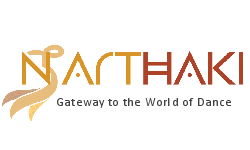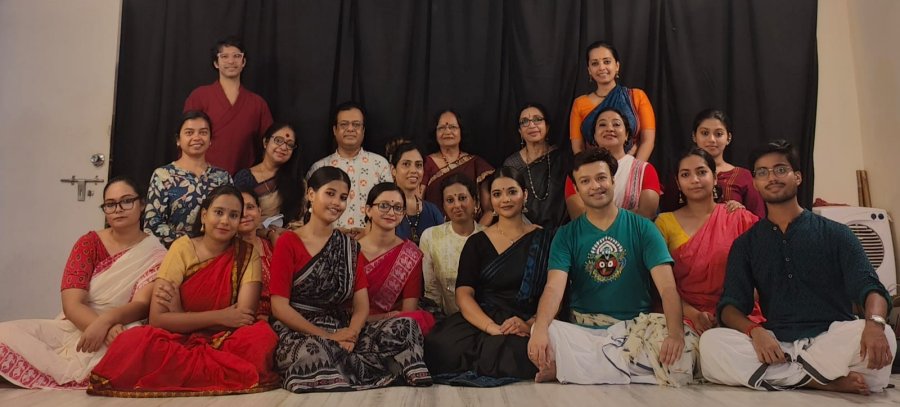
|
 |

|
 |
Tradition in Motion: Daksha Mashruwala on Choreography and Continuity - Ratikant Mohapatra e-mail: srjan.bbsr@gmail.com Photos: Ratikant Mohapatra & Namrata Meheta April 23, 2025 My association with Guru Daksha Mashruwala spans over four enriching decades. Both of us had the profound privilege of learning under the guidance of my revered father and Guru, Kelucharan Mohapatra. Over the years, I have watched Daksha Mashruwala evolve into a complete artiste - someone whose journey in Odissi reflects depth, dignity, and devotion. Her understanding of the art form is layered and sensitive, and she brings a unique finesse to both performance and pedagogy. Her contribution in nurturing young minds and imparting meaningful training is commendable. What sets her apart is her integrity as a teacher and her sincerity in upholding the purity of the form. I have always admired her for her consistent work as an artiste and for being a generous, unbiased, and kind-hearted human being. It is always a pleasure to witness her engage with students, inspiring them with knowledge and humility in equal measure. During my recent visit to Kolkata for my fellowship project work, I coincidentally met Daksha Mashruwala. This serendipitous meeting offered me the opportunity to engage in heartfelt and insightful dialogue with her. The conversations that followed became the foundation for this candid and enriching interview. It was truly a moment of shared reflections—rooted in memory, learning, and the timeless bond of Guruji’s teachings.  How was your overall experience conducting the workshop in Kolkata under the aegis of the Odissi Dancers’ Forum? The workshop in Kolkata was an enriching and heartwarming experience. The Odissi Dancers’ Forum provided a nurturing and focused environment, and I felt deeply encouraged by the seriousness and dedication of the participants. It was a joy to witness the city's vibrant cultural energy channelled into the practice space each day. You taught two distinct pieces – “Kaapi Madhuri Puna” and “Prana Sanginire”. What inspired your choice of these particular choreographies for the workshop? I chose these two pieces to offer the students a journey into both the lyrical and the dramatic aspects of Odissi. “Kaapi Madhuri Puna”, an exquisite ashtapadi, unfolds through delicate sringara, while “Prana Sanginire” is rooted in emotive Odia abhinaya, rich with grounded expression. Beyond their contrast in mood and technique, these items have been a significant part of my personal repertoire. I have performed and taught them extensively over the years, and for this very reason, the students expressed a desire to learn these particular pieces during the workshop. Most of the dancers in Kolkata were not familiar with these compositions, and that further motivated the decision. But more importantly, both pieces are the choreographic gems of Guru Kelucharan Mohapatra. I believe that such masterpieces must not remain confined to a few practitioners. They deserve to be transmitted, studied, and experienced by as many dancers as possible. This is how Guruji’s artistic legacy will continue to live and breathe through generations. It is my heartfelt intention that his choreographies do not fade away with time, but instead, leave an indelible impression in the collective memory of Odissi practitioners everywhere. That is the core reason why I chose to teach these two pieces in the workshop.  Could you share your memories of learning these items from Guru Kelucharan Mohapatra? What nuances do you still hold dear from those early sessions? Learning from Guruji was always an experience of revelation. He never simply taught steps—he breathed life into every phrase, every movement. With “Kaapi Madhuri Puna,” I remember his emphasis on the subtle play of glances, the fluidity of transitions, and the internalization of Radha’s yearning. In “Prana Sanginire,” it was the grounding in bhava that stood out. Even today, I can hear his voice guiding me through the pauses, the silences, and the breath between the gestures. These memories remain my inner compass. How did the participants respond to the emotional depth and technical challenges in “Kaapi Madhuri Puna”, which is rich in sringara rasa? I was truly touched by the sincerity of the students. Though sringara can be elusive and deeply personal, many of them responded with sensitivity and openness. Some brought a quiet intensity to Radha’s longing, while others explored the rasa with restrained grace. Of course, technical challenges were present—especially in conveying the emotional subtlety without overstatement—but I saw genuine effort to grasp the inner world of the piece. “Prana Sanginire” being an Odia abhinaya piece, how did the students unfamiliar with the language connect with its emotional landscape? Language can be a barrier only on the surface. Once the emotional essence is accessed, the dancer finds a way to communicate. I spent time explaining the lyrical content and the emotional subtext, and the students gradually began to internalize the mood. Their interpretations, though still evolving, were honest and heartfelt. It was rewarding to see the poetry of the language transform into embodied emotion.  You interacted with students from varied backgrounds and training. What differences did you notice in their approach to learning Guruji’s choreographies? Each dancer brings their own sensibility to the learning process. Some came with strong technique, others with expressive intuition. What mattered most to me was their willingness to unlearn and absorb. Guruji’s works demand a blend of precision and surrender—and I encouraged them to approach the choreographies not merely as sequences, but as living texts that reveal themselves slowly. I noticed that those who allowed the dance to breathe through them made the deepest impressions. As a teacher, what do you emphasize most while transmitting Guru Kelucharan Mohapatra’s works—technique, emotion, or the spiritual essence? All three are essential, and one must never exist without the other. But I often find myself emphasizing the inner intent—the spiritual essence. Guruji's work was never about mere form; it was always a search for truth through beauty. Technique serves expression, and expression emerges from feeling. If the dancer can cultivate this alignment, the dance becomes a path of sadhana. Were there any particular moments during the workshop where you felt a deep resonance between the students and the pieces being taught? Yes, several times. In particular, during the final sessions of “Prana Sanginire,” there were moments when the room was heavy with silence—not of exhaustion, but of emotional stillness. It was as though the students had touched something authentic within themselves. Watching their eyes speak, their movements flow with quiet conviction—it was deeply moving for me. How do you ensure the integrity of Guruji’s style and vision while adapting to the needs of contemporary learners? Guruji’s style was timeless because it emerged from truth, not trend. I remain rooted in his teachings, but I try to meet students where they are—offering clarity, context, and care. Sometimes, the language of explanation changes, or analogies are adapted, but the core remains untouched. My role is to be a faithful vessel of his vision, while allowing each dancer to discover their own relationship with it.  How do you see the Odissi tradition influencing today’s practitioners to evolve, while maintaining the purity of the form? Odissi, in its essence, is a living tradition—rooted in antiquity yet always flowering in the present. For today’s practitioners, the tradition offers a strong anchor. It reminds us that evolution does not mean dilution. When one is deeply grounded in the grammar, aesthetics, and philosophical underpinnings of the form, growth becomes organic rather than ornamental. I see many young dancers today striving to maintain this delicate balance—drawing from the classical core, yet bringing in their individuality with grace and awareness. The tradition is influencing them not by imposing rules, but by offering a lineage of wisdom that they can embody and interpret with authenticity. What would you say is the responsibility of a practitioner or teacher in preserving the sanctity of the form while adapting to changing times? Our foremost responsibility is to honour the integrity of the form—its vocabulary, its spirit, and its sacred lineage. As teachers and performers, we are not merely transmitters of technique, but carriers of a vision. Adaptation is natural and even necessary, but it should emerge from understanding, not from convenience. We must ask ourselves: are we evolving the form, or are we editing it to fit a transient trend? The sanctity lies not in resisting change, but in guiding it with discernment. As long as our choices arise from deep respect and clarity, we remain true to the path. Guruji often said, “Dance is not for showing, but for sharing.” That spirit must remain at the heart of all we do. Finally, what message would you like to give to the younger generation of Odissi dancers who are engaging with Guru Kelucharan Mohapatra’s legacy through such workshops? Approach the legacy with humility, patience, and reverence. Guruji’s work is not to be consumed; it is to be lived. Do not rush to perform—take time to absorb, to reflect, to feel. Let each movement be an offering, and each performance a prayer. Only then can you truly honour the legacy—not just in body, but in spirit.  Ratikant Mohapatra, as Director of Srjan and Dean of the Faculty of Arts, Communication, and Indic Studies at Sri Sri University, stands as a distinguished figure in Indian classical dance. With a career spanning over 40 years, his artistry as a dancer, choreographer, and educator has profoundly shaped Odissi's journey. Under his guidance, Srjan has earned national and global acclaim, merging neo-classical innovation with traditional grace. Honoured with the Central and State Sangeet Natak Akademi Awards and a Guinness World Record for orchestrating 555 Odissi dancers, his legacy reflects a steadfast dedication to the evolution and timeless beauty of Odissi. Post your comments Please provide your name and email id when you use the Anonymous / blog profiles to post a comment. All appropriate comments posted with name and email id in the blog will be featured in the site. |